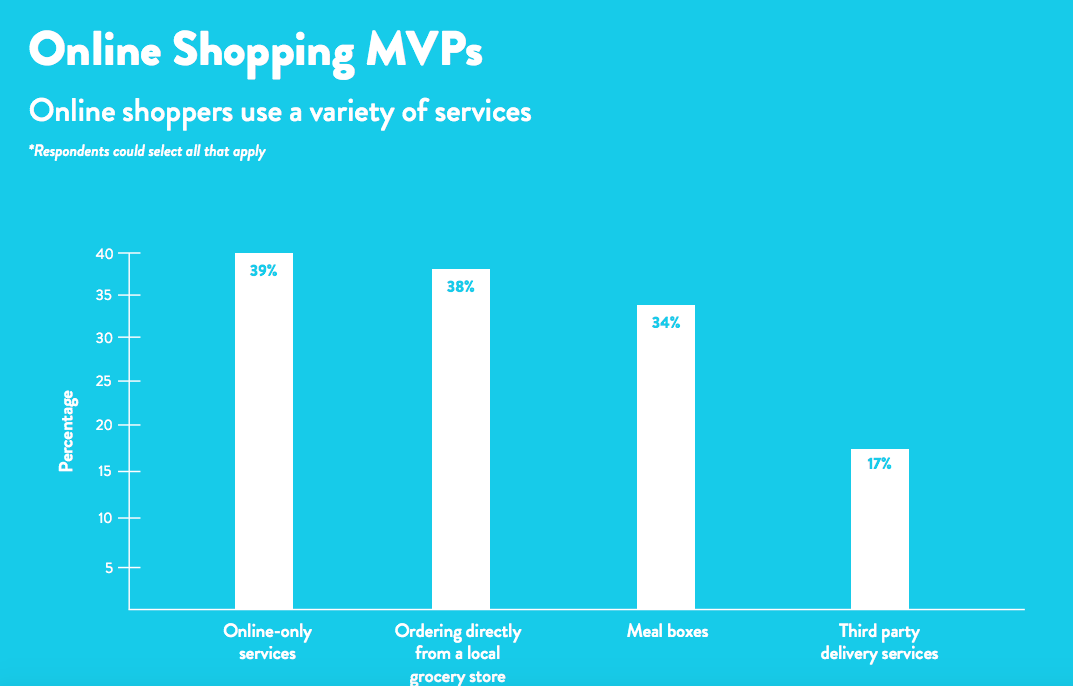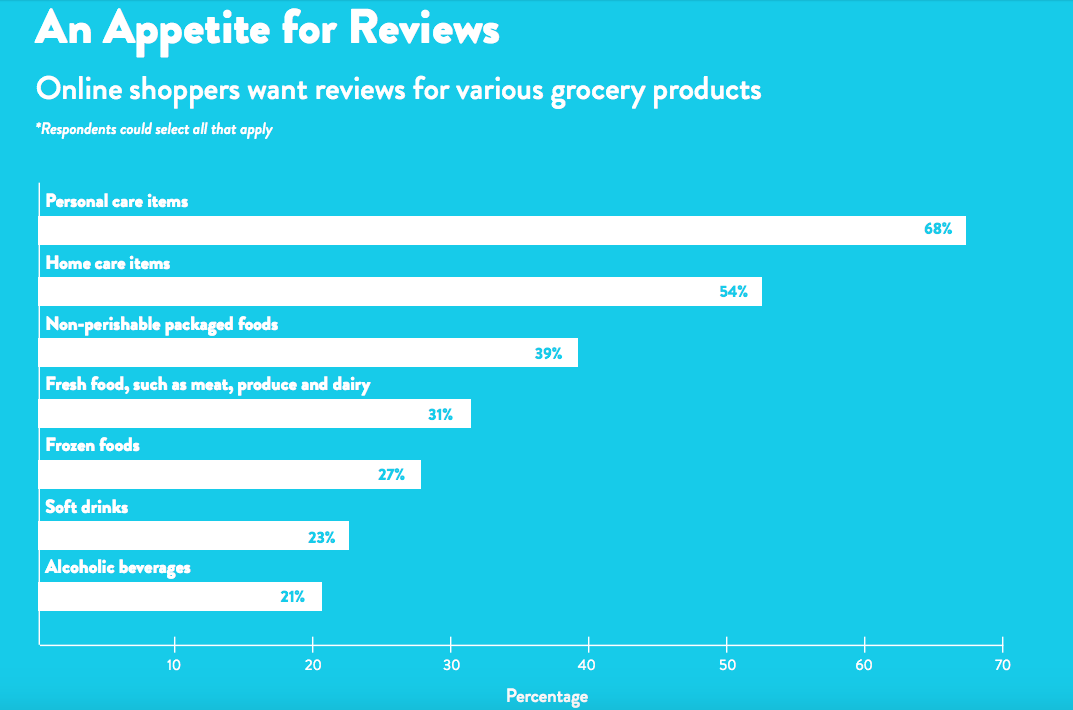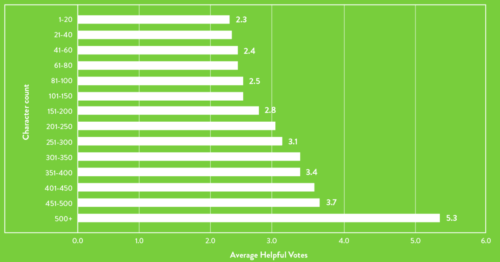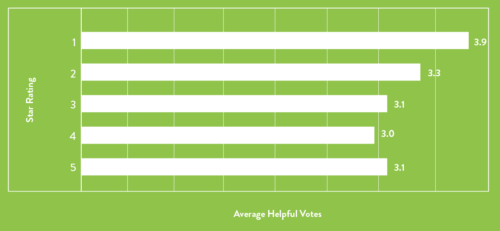There was a time, in the not so distant past, when the only option for purchasing groceries was to head to the local grocery store. Fast forward to today, and consumers have a growing number of online grocery shopping options.
Yet despite the growing number of choices, our recent survey of more than 1,000 U.S. consumers found that less than a quarter (17%) are purchasing groceries online today. However, as expected, we also found that consumers residing in larger cities are significantly more likely to purchase groceries online than their rural counterparts. Nearly a quarter (23%) of consumers living in a city with a population of 500,000 or more have made an online grocery purchase in the last 90 days, compared to 10% of consumers who reside in a town with a population of less than 50,000.
While these numbers may seem small, the number of consumers who choose to shop for groceries online will only continue to grow. Read on to find out what we learned about why consumers are opting to shop for groceries online and what information they’re using to make informed purchase decisions. By better understanding the grocery shopping habits of today’s consumers, you’ll be better equipped to develop strategies to effectively reach, convert and retain these shoppers across channels.
Consumers Shop Online to Save Time and Access Information
Consumers lead busy lives and are always on the lookout for ways to maximize their time. So, as anticipated, saving time is the most popular reason consumers purchase groceries online, with 72% indicating it’s a key reason they choose to do so.
[bctt tweet=”72% of online grocery shoppers shop online to save time.” username=”powerofreviews”]
Shoppers also appreciate the access to information that online grocery shopping provides. 36% indicate that online shopping makes it easier to compare products and prices online, and 27% like that they can easily access information about products, including reviews.
Other top reasons for shopping for groceries online include avoiding impulse purchases that often happen in-store (30%) and avoiding the hassle of getting to a grocery store (23%).
Shoppers Use a Variety of Online Grocery Services
Depending on geographic area, there are a variety of online grocery shopping options available to consumers. Our research found that online-only services (think Peapod, AmazonFresh or Jet.com) are the most popular option — 39% of online grocery shoppers say they’ve used this type of service in the last 90 days. Following closely behind is ordering directly from a local grocery store for pickup or delivery (commonly referred to as click-and-collect), with 38% of online grocery shoppers using this service.
Meal boxes — such as HelloFresh and BlueApron — are another popular option, with 34% of online grocery shoppers using these services in the past 90 days. Surprisingly, only 17% of online grocery shoppers have used a third party service — such as Instacart — that pairs consumers with a personal shopper who purchases groceries from a local grocery store, then delivers them to the consumer’s home. This is likely because these services are often only available in densely populated metropolitan areas.

Shoppers Purchase a Variety of Grocery Items Online
Grocery shopping is a sensory experience—much more so than other product categories. Consumers who shop in a store have the opportunity to touch, smell and even taste items to assess their quality and freshness. It’s much more difficult to judge the quality of fresh food items—such as meat and produce—when shopping online.
So it comes as no surprise that shelf-stable goods are the most popular grocery items to purchase online. 58% of online grocery shoppers purchase non-perishable packaged foods (such as cereal, canned soups and snack foods), 49% purchase personal care items (such as soap, shampoo and body wash) and 45% purchase home care items (such as detergent and cleaners).
But, as the survey results reveal, online grocery shoppers aren’t completely steering clear of fresh food purchases online. Nearly half (47%) of them shop online for fresh food, such as meat, produce and dairy. Other popular grocery items shoppers are purchasing online include frozen foods (32%), soft drinks (33%) and alcoholic beverages (12%).
Online Grocery Shoppers Read Reviews
Ratings and reviews have become a key part of the path to purchase, regardless of what a consumer is shopping for. And our survey found that online grocery is no exception. If reviews are available on an online grocery service’s website, 93% of shoppers will read them at least occasionally. And most online grocery shoppers read them much more often. 19% of online grocery shoppers always read reviews for grocery items, and an additional 34% read them regularly.
Reviews Influence Online Grocery Shoppers
Thanks to our previous research with Northwestern University, we know that reviews are especially impactful for new or unknown brands and products. It makes sense, then, that 72% of online grocery shoppers indicate that they are more likely to purchase a grocery item they’ve never purchased before if there are customer reviews for that product.
Online grocery shoppers are turning to reviews—and this content is influencing their purchases. Grocery retailers: make sure you have plenty of reviews available for plenty of your products, especially those that are new to market.
Shoppers Want Reviews for a Variety of Grocery Products
Clearly, consumers are turning to reviews when they’re shopping online for groceries. But are they looking for reviews for specific types of grocery products more than others?
We found out that the top categories online shoppers want to access product reviews for are personal care items (68%), home care items (54%), non-perishable packaged foods (39%) and fresh food, such as meat, produce and dairy (31%). Other top categories include frozen foods (27%), soft drinks (23%) and alcoholic beverages (21%). Since consumers want reviews for a variety of products, it’s important to maximize your review coverage, which is the number of products in your catalog that have reviews.

Online Shoppers Want Reviews Directly on the Ecommerce Website or App
Online grocery shoppers want to find reviews—and they don’t want to look hard to find them. Here’s the breakdown of where online shoppers prefer to find review content for grocery products.
- 53% want to find reviews directly on the website or app they’re using to purchase their groceries
- 38% want to find reviews on Amazon
- 9% want to find reviews on a third party review site
It’s key for grocery retailers to provide all of the information shoppers are looking for in one place. Retailers that don’t prominently feature product reviews directly on their website or mobile app risk losing shoppers to Amazon or another service that does.
Wrapping Things Up
Today, less than a quarter of consumers are purchasing their groceries online. But this number will only continue to grow as options increase and consumers expect the convenience of online shopping. If you’re a grocery brand or retailer, now’s the time to develop a strategy to effectively reach shoppers across channels.








